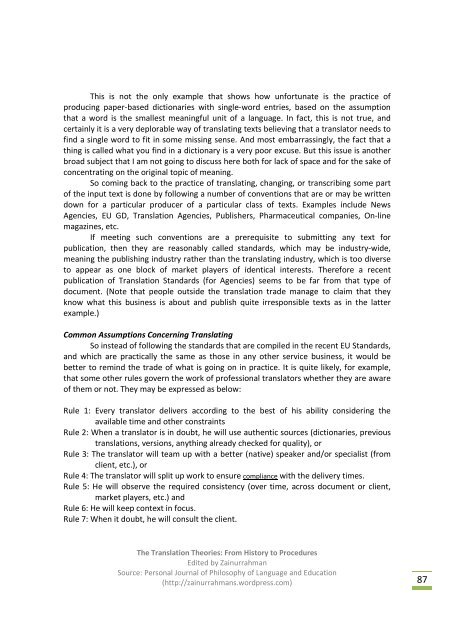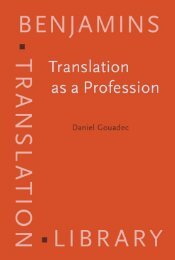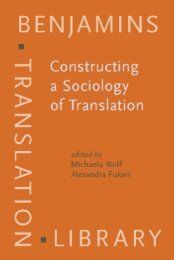Translation Theories.pdf
Translation Theories.pdf
Translation Theories.pdf
You also want an ePaper? Increase the reach of your titles
YUMPU automatically turns print PDFs into web optimized ePapers that Google loves.
This is not the only example that shows how unfortunate is the practice of<br />
producing paper-based dictionaries with single-word entries, based on the assumption<br />
that a word is the smallest meaningful unit of a language. In fact, this is not true, and<br />
certainly it is a very deplorable way of translating texts believing that a translator needs to<br />
find a single word to fit in some missing sense. And most embarrassingly, the fact that a<br />
thing is called what you find in a dictionary is a very poor excuse. But this issue is another<br />
broad subject that I am not going to discuss here both for lack of space and for the sake of<br />
concentrating on the original topic of meaning.<br />
So coming back to the practice of translating, changing, or transcribing some part<br />
of the input text is done by following a number of conventions that are or may be written<br />
down for a particular producer of a particular class of texts. Examples include News<br />
Agencies, EU GD, <strong>Translation</strong> Agencies, Publishers, Pharmaceutical companies, On-line<br />
magazines, etc.<br />
If meeting such conventions are a prerequisite to submitting any text for<br />
publication, then they are reasonably called standards, which may be industry-wide,<br />
meaning the publishing industry rather than the translating industry, which is too diverse<br />
to appear as one block of market players of identical interests. Therefore a recent<br />
publication of <strong>Translation</strong> Standards (for Agencies) seems to be far from that type of<br />
document. (Note that people outside the translation trade manage to claim that they<br />
know what this business is about and publish quite irresponsible texts as in the latter<br />
example.)<br />
Common Assumptions Concerning Translating<br />
So instead of following the standards that are compiled in the recent EU Standards,<br />
and which are practically the same as those in any other service business, it would be<br />
better to remind the trade of what is going on in practice. It is quite likely, for example,<br />
that some other rules govern the work of professional translators whether they are aware<br />
of them or not. They may be expressed as below:<br />
Rule 1: Every translator delivers according to the best of his ability considering the<br />
available time and other constraints<br />
Rule 2: When a translator is in doubt, he will use authentic sources (dictionaries, previous<br />
translations, versions, anything already checked for quality), or<br />
Rule 3: The translator will team up with a better (native) speaker and/or specialist (from<br />
client, etc.), or<br />
Rule 4: The translator will split up work to ensure compliance with the delivery times.<br />
Rule 5: He will observe the required consistency (over time, across document or client,<br />
market players, etc.) and<br />
Rule 6: He will keep context in focus.<br />
Rule 7: When it doubt, he will consult the client.<br />
The <strong>Translation</strong> <strong>Theories</strong>: From History to Procedures<br />
Edited by Zainurrahman<br />
Source: Personal Journal of Philosophy of Language and Education<br />
(http://zainurrahmans.wordpress.com) 87

















